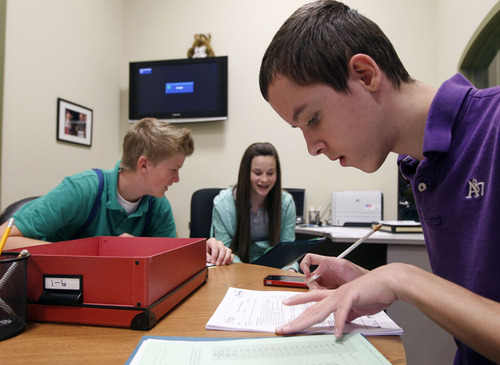This is an archived article that was published on sltrib.com in 2014, and information in the article may be outdated. It is provided only for personal research purposes and may not be reprinted.
Washington • The United States runs in the middle of the pack when it comes to the financial knowledge and skills of 15-year-old boys and girls, according to an international study released Wednesday.
China's financial hub of Shanghai had the highest average score for teens who participated in the testing for the Paris-based Organization for Economic Cooperation and Development. A total of 18 countries and economies were studied. Shanghai was followed by the Flemish Community of Belgium, Estonia, Australia, New Zealand, the Czech Republic, Poland, Latvia, the U.S., Russia and France.
At the bottom of the list: Croatia, Israel, the Slovak Republic, Italy and Colombia.
The testing is part of OECD's Program for International Student Assessment, which aims to evaluate education systems worldwide. This is the program's first assessment of financial literacy of teens.
The questions on the two-hour paper test ranged from simple to complex.
The easiest questions asked students to display basic financial literacy skills, such as recognizing the purpose of an invoice or comparing prices per unit to determine which had a better value.
The most difficult asked students to analyze more complicated scenarios, such as reviewing two loan proposals with differing rates and terms and choosing the better offer.
Shanghai notched the top average score of 603 points on the test. The U.S., by comparison, had an average score of 492, and Colombia, at the bottom, scored 379.
So what is Shanghai doing right?
Michael Davidson, head of schools for the OECD, says Shanghai schools identify students who are struggling and provide the support they need. Successful systems, he said, are ones that don't let students fall behind.
The financial literacy study was administered in 2012 to approximately 29,000 15-year-old students in 13 OECD countries and economies and five partner countries and economies.
Across all 18 countries and economies, only 1 in 10 students could solve the hardest financial literacy questions on the test, the report said.
In the U.S., only 9.4 percent of the students taking part in the study were able to solve the most difficult questions. More than 1 in 6 U.S. students did not reach the baseline level of proficiency in financial literacy. At best, said the report, those students could make only simple decisions on everyday spending.
The OECD's Davidson said being grounded in financial literacy is crucial to teens preparing to decide whether to enter the job market or embark on college and university educations.
Many, he said, already use financial products in their daily lives. In the U.S., for example, about 50 percent of the 15-year-olds said they have a bank account. About 15 percent said they have a prepaid debit card. —
Financial literacy
Average scores achieved by 15-year-olds on the Program for International Student Assessment financial literacy test conducted for the Paris-based Organization for Economic Cooperation and Development:
Country or economy and its mean score
Shanghai-China, 603
Flemish Community of Belgium, 541
Estonia, 529
Australia, 526
New Zealand, 520
Czech Republic, 513
Poland, 510
Latvia, 501
United States, 492
Russian Federation, 486
France, 486
Slovenia, 485
Spain, 484
Croatia, 480
Israel, 476
Slovak Republic, 470
Italy, 466
Colombia, 379



